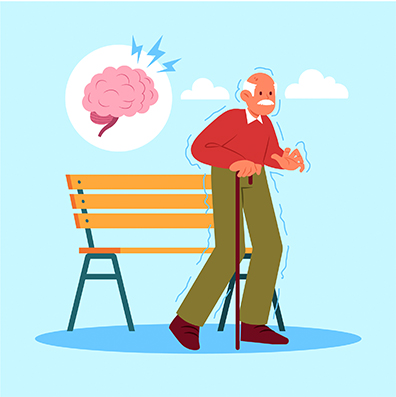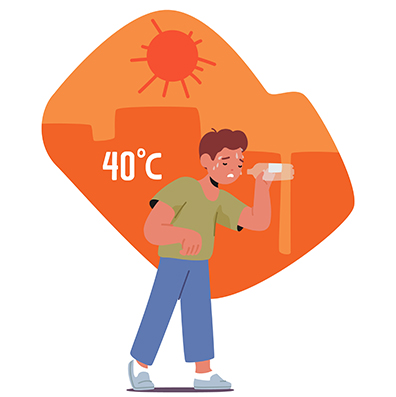Insight Neurology – With 2023 being the warmest year on Earth in a half century, the Centers for Disease Control and Prevention (CDC) reported a substantial increase in emergency room visits for heat-related illnesses in many parts of the United States last year. Although certain groups, including children, pregnant women, and people with underlying health conditions are most at risk for heat illnesses, visits were particularly high last year among males and adults aged 18-64, making this a significant public health concern as we experience more frequent episodes of extreme heat.
Heat illness encompasses a range of conditions caused by exposure to excessive heat, including rashes, cramping, and exhaustion that can often be treated at home. However, the most dangerous form of heat illnesses is heat stroke, which occurs when the body’s temperature rises to dangerous levels (above 104°F). When the body overheats to this extent, it can have severe effects on the brain due to the organ’s sensitivity to temperature changes and its high energy demand. As we enter the warmest months of the year, here is what happens to the brain during heat stroke and what to do if you or someone you know experiences this life-threatening emergency.

Brain Swelling
Also known as cerebral edema, swelling of the brain will occur during heat stroke. This is because extreme heat causes the blood vessels in the brain to dilate or widen, resulting in increased blood flow and pressure in the brain. Fluid will leak from the blood vessels into the surrounding brain tissue when this happens, causing dangerous swelling.

Brain Function Disruption
Once swelling begins in the brain, it will start to compress the surrounding structures and interfere with normal brain function. This leads to common heat stroke symptoms such as confusion, disorientation, dizziness, headache, and loss of consciousness.
Neurological Symptoms
When left untreated, heat stroke-related neurological symptoms may develop. This can range from seizures and coma to brain damage. These symptoms are the direct effects of heat on the brain cells and the disruption of neurotransmitter activity.

Altered Cognitive Function
Another common result of heat stroke is altered cognitive function, a condition that affects memory, attention, and decision-making abilities. It may also be difficult to process information and regulate emotions when cognitive function is impaired.
Risk of Permanent Damage or Death
Although heat stroke can be managed with early intervention, it is possible to experience permanent brain damage or even death without prompt treatment. This is because high body temperature can cause proteins within the brain cells to change, resulting in dysfunction and death. Additionally, extended exposure to heat can also lead to failure of multiple organs, including the brain.

Signs of Heat Stroke
Heat stroke is a serious medical condition that requires immediate attention, which is why it is crucial to understand the signs and know what to do when symptoms develop. Here are some of the key signs of heat stroke to watch for:

- High body temperature (over 104°F)
- Confusion, agitation, slurred speech, irritability, and seizures
- Skin that feels hot and dry to the touch (non-exertional heat stroke); heavy sweating (exertional heat stroke)
- Nausea and vomiting
- Flushed (red) skin
- Rapid breathing
- Racing heartbeat
- Headache
- Dizziness
If you or someone you are with experiences any of the above signs of heat stroke, it is crucial to seek emergency medical care or dial 911. While waiting for help, move to a cooler environment, remove heavy clothing, and apply cool water, cloths, or ice packs to the skin. Heat stroke is preventable, so always remember to stay hydrated, wear appropriate clothing for the conditions, take frequent breaks, and avoid strenuous activities in extreme heat. For more information about heat stroke, treatment for neurological conditions, or to schedule an appointment at Insight, contact us today.

FAQ
Q: What are the risk factors for heat stroke?
A: Although anyone can experience heat stroke, there are certain risk factors that increase the likelihood of experiencing this life threatening condition. Common risk factors include strenuous physical activity in high temperatures or humidity, age (young children or older adults), chronic illnesses, certain medications, and alcohol use.
Q: What is the difference between heat stroke and heat exhaustion?
A: Heat exhaustion is a less severe form of heat illness, but it can develop into heat stroke. Symptoms of heat exhaustion include heavy sweating, weakness, cold/clammy skin, and nausea.
Q: Are heat stroke symptoms different in children?
A: The signs and symptoms of heat stroke can differ in children. In addition to the adult symptoms listed in this blog, infants and children may also experience irritability, lethargy, poor feeding (infants), reduced urination, and dry mouth.

